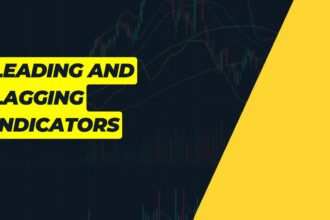Written By: Kaushal Sharma
In trading, indicators are mathematical tools used to analyze past price movements, volume, or other market data to help traders make informed decisions about future price actions. These indicators provide valuable insights into market trends, momentum, volatility, and potential reversals, and can help traders identify entry and exit points.
Indicators can be broadly classified into two categories: leading indicators and lagging indicators.
Leading Indicators: These helps forecast future price movements. They often provide early signals of potential trends. Examples include the Relative Strength Index (RSI) and Moving Average Convergence Divergence (MACD). These tools are useful for predicting reversals or trend continuations before they happen.
Lagging Indicators: These are used to confirm trends that have already started. They tend to follow the market’s action and are less useful for predicting future changes. Common lagging indicators include Moving Averages (MA) and the Average Directional Index (ADX). They help traders gauge the strength and duration of a trend, rather than its direction.
Leading Indicators:
Leading indicators are used primarily for predicting future price movements. They aim to provide early warnings or signals of upcoming trends. Traders rely on leading indicators to catch potential reversals, or trend shifts before they fully develop. Here’s a breakdown of the key points:
Characteristics of Leading Indicators:
– Predictive Nature: Leading indicators anticipate future price movements, helping traders to make decisions ahead of time.
– Early Entry Signals: By providing signals in advance, these indicators can help traders enter positions early, potentially maximizing profits if trends play out as expected.
– Volatility: They can sometimes be more volatile or less reliable in comparison to lagging indicators, as they react to market conditions more quickly.
Examples of Leading Indicators:
Relative Strength Index (RSI): The Relative Strength Index (RSI) is a momentum oscillator that measures the speed and magnitude of recent price changes to evaluate overbought or oversold conditions in a market. RSI values range from 0 to 100, with readings above 70 typically indicating overbought conditions and readings below 30 suggesting oversold conditions. Traders use RSI to identify potential trend reversals and confirm price momentum. Additionally, RSI can help detect bullish or bearish divergences, where price action and RSI movement diverge, often signaling a trend shift.

Fibonacci Retracement: It is a widely used technical analysis tool that helps traders identify potential support and resistance levels in the market. The concept behind Fibonacci retracement is based on the idea that markets tend to retrace or pull back a predictable portion of a previous move before continuing in the original direction. This concept is derived from the Fibonacci sequence, a series of numbers where each number is the sum of the two preceding ones, and the key ratios derived from it are used to predict potential price levels.
1. 100% Fibonacci Retracement indicates a future market price reversal
2. 0% indicates a future market trend confirmation
3. 61.8% indicates a weak future trend
4. 38.2% indicates a strong future trend
Support and Resistance: Support and resistance levels are key price levels where buying or selling pressure tends to prevent further price movement. Support is a price level where demand is strong enough to halt a downtrend, while resistance is a level where selling pressure prevents an asset from rising further. These levels are critical in technical analysis, as they help traders identify entry and exit points, set stop losses, and determine potential price breakouts. A break above resistance or below support can indicate a trend continuation or reversal, making these levels essential for strategic decision-making.

Lagging Indicators:
Lagging indicators are tools used in technical analysis that help confirm trends that have already started, rather than predicting future price movements. These indicators “lag” behind the price action because they are based on past data and are used primarily to validate whether a trend is continuing or losing strength. Unlike leading indicators, which provide early signals of potential price changes, lagging indicators are more reliable for confirming the trend’s strength and direction after the price movement has occurred.
Characteristics of Leading Indicators:
– Trend Confirmation: Lagging indicators are primarily used to confirm existing trends. They do not predict future price movements but rather provide confirmation that a trend is in motion.
– Delayed Signals: Since lagging indicators are based on historical price data, they generate signals after the trend has already begun. This means traders may enter a trade later than they would with leading indicators, missing some of the early price movement.
– Reliability and Reduced False Signals: Lagging indicators tend to be more reliable because they are based on actual price movement and established patterns. Unlike leading indicators, which can produce false signals due to market noise or sudden price changes, lagging indicators give signals that align more closely with the market’s actual trends.
Examples of Leading Indicators:
Moving Averages (Simple and Exponential): Moving Averages (MA) smooth out price data to identify trends. The 50-day SMA helps identify medium-term trends, while the 200-day SMA is used for long-term trends. A popular strategy involves crossover signals, like when the 50-day crosses above the 200-day, known as a “golden cross,” indicating a bullish trend. Conversely, a “death cross,” when the 50-day crosses below the 200-day, suggests a bearish trend. These crossovers help traders decide on entry or exit points.
The 200-day Simple Moving Average (SMA) represents the average closing price of a stock over the past 200 days or candles and is used to gauge long-term trends. The 50-day SMA calculates the average closing price over the last 50 days, helping identify medium-term trends.
The Simple Moving Average (SMA) calculates the average price of a stock over a specific period by giving equal weight to all data points. For example, a 50-day SMA takes the sum of closing prices over the last 50 days and divides it by 50.
The Exponential Moving Average (EMA) also calculates the average price but gives more weight to recent data points, making it more responsive to price changes. This makes the EMA more useful for identifying short-term trends compared to the SMA, which reacts slower to price movements.

Average True Range (ATR): The ATR measures market volatility, usually calculated over 14 periods. Higher ATR values, such as 2.5, indicate strong volatility, signaling a strong trend, while lower values like 0.5 suggest a weak trend or consolidation. ATR helps traders adjust stop-loss levels and determine the strength of a trend.
Let’s take an example of a stock priced at ₹50 and see how the Average True Range (ATR) works.
Scenario 1: High Volatility (ATR = 2.5)
- If the ATR is 2.5, the stock moves an average of ₹2.5 per day (either up or down) over the chosen period (e.g., 14 days).
- This means the stock has a daily fluctuation of 5% (2.5/50 × 100), indicating high volatility.
- A trader setting a stop-loss might place it at least ₹2.5 away from the entry price to account for natural price swings and avoid getting stopped out prematurely.
- Example: If a trader buys at ₹50, a reasonable stop-loss could be around ₹47.5 (50 – 2.5).
Scenario 2: Low Volatility (ATR = 0.5)
- If the ATR is 0.5, the stock moves only ₹0.5 per day on average, showing low volatility or consolidation.
- The daily fluctuation is 1% (0.5/50 × 100), meaning the price is relatively stable.
- A trader setting a stop-loss might place it closer to the entry price, around ₹0.5 away, since the stock is not making large moves.
- Example: If a trader buys at ₹50, a stop-loss could be set around ₹49.5 (50 – 0.5).
How ATR Helps Traders
- Breakout Confirmation: If ATR increases from 0.5 to 2.5, it suggests a volatility surge, confirming a strong breakout.
- Risk Management: Traders use ATR-based stop-loss to avoid being stopped out by normal fluctuations while still managing risk effectively.
- Trend Strength: A rising ATR signals strong price movement, while a declining ATR suggests a weakening trend or consolidation.

Volume Indicators: Volume indicators track traded volume, confirming trend strength. Rising volume, such as above 1 million shares, indicates strong buying pressure, while falling volume, below 500,000 shares, signals weakening momentum. Indicators like On-Balance-Volume (OBV) help traders assess whether a trend is supported by solid market participation.

| Feature | Leading Indicators | Lagging Indicators |
| Purpose | Predict future price movements | Confirm past price movements |
| Risk | Higher risk, more speculative | Lower risk, more reliable |
| Timing | Ahead of the trend, earlier signals | After the trend has started |
| Trading Style | Short-term, speculative, contrarian | Trend-following, longer-term |
Using Both Indicators Together
Many traders combine both leading and lagging indicators to optimize their strategies. For example, a trader might use a leading indicator (like RSI) to predict when a market is overbought or oversold, then use a lagging indicator (like a moving average) to confirm the strength and direction of the trend.
Example of Combining Indicators:
– Step 1: The trader uses a leading indicator, such as the RSI, to identify an overbought or oversold condition.
– Step 2: They wait for a trend confirmation using a lagging indicator like the 50-day moving average.
– Step 3: If the price crosses the moving average and the stochastic shows a reversal, the trader might decide to enter the market.
Limitations of Both Indicators

Neither leading nor lagging indicators are inherently better; their effectiveness depends on the trader’s style and market conditions. Day traders and scalpers often prefer leading indicators as they provide early signals for quick entries and exits, helping them capitalize on short-term price movements. In contrast, swing traders and long-term investors tend to rely more on lagging indicators, which confirm established trends and reduce the risk of false signals. A combination of both can enhance decision-making, such as using RSI (leading) to identify potential reversals and moving averages (lagging) to confirm trend direction, creating a more balanced and strategic approach to trading.






